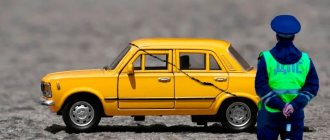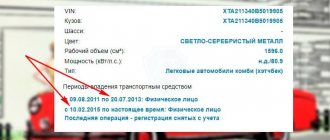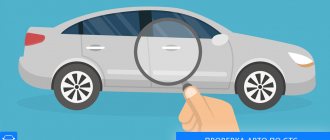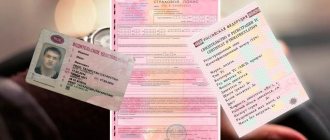What prohibitions and restrictions may apply to vehicles?
It could be:
- prohibition or restrictions on registration activities;
- prohibition from undergoing technical inspection:
Such a punitive measure was often used several years ago, because car owners have to undergo maintenance much more often than register a car, which means that it was possible to force the debtor to pay the bills much faster. However, the ban on undergoing maintenance deprived the car owner of the right to purchase an MTPL policy. Car owners filed lawsuits en masse about the illegality of the actions of bailiffs and won the cases. This forced FSSP employees to practically abandon the use of this measure.
- ban on disposal.
The most common punitive measures today are a ban or restriction of state registration.
How to check a car for restrictions?
Information about the ban is stored in the traffic police database, and you can check this information using the traffic police website or the FSSP. Below we will look at these verification methods.
Check through the traffic police website
The check is carried out like this:
- Open the traffic police website, select “Services” and “Car check” or follow the direct link https://gibdd.rf/check/auto.
- Enter the vehicle’s VIN code, select “Restrictions” and click the “Request Verification” button. Wait for the operation to complete.
- If there is a ban, then a special window will pop up, where all the basic information about the ban will be indicated (the basis for imposing the ban, the court order, the name of the bailiff, and so on). If there is no prohibition, a window will pop up indicating that the relevant information was not found.
Check through the FSSP
You can also check the information through the Bailiffs website:
- Open the FSSP website, select “Services” and “Bank of Production” or follow the direct link https://fssprus.ru/iss/ip.
- Enter your region of residence, full name and date of birth, and then find the “Find” button. At the end, a window will open in which it will be indicated whether the machine is prohibited or not.
- Using the FSSP website, you can also find out the details of the ban: to do this, through the traffic police website, find the resolution on imposing restrictions and copy the resolution number - then in the search menu on the FSSP website, select “Search by individual entrepreneur”, insert the resolution number and click the “Find” button "
More on the topic: New certificate of accident from October 20, 2021
Who can restrict or ban state registration and for what?
The list of authorities is presented in the Order of the Ministry of Internal Affairs “On the procedure for registering vehicles” (N1001 dated November 24, 2008). Among other things, it says that a ban or restriction may be imposed:
- by a court order (for non-payment of taxes, late payment of traffic police fines, debts to utility or credit organizations, as well as during the division of property);
- investigative authorities (if the car is wanted);
- Traffic police (if external discrepancies are detected in the car with the characteristics specified in the technical passport);
- social protection authorities;
- customs representatives (in case of violations of import rules or indication of false information about the vehicle);
- other bodies vested with the necessary powers.
Does it make sense to buy a car with restrictions?
It is not recommended to buy a car with restrictions, since you will not be able to re-register it in your name until the former owner removes the restrictions. Since re-registration is not available to you, you will not be able to obtain a license for the car, so you will not have the legal opportunity to drive the car. Actual driving of such a car is equivalent to driving a vehicle without documents, for which a fine and suspension from driving followed by evacuation are provided.
More on the topic: Road repairs have been completed, but temporary signs have not been removed - is the fine legal?
What are the risks of buying a car with restrictions?
A car with a court ban on registration actions will not be able to go through the registration procedure with the traffic police. The new owner has ten days from the date of purchase of the car to do this. Otherwise, according to Article 19.22 of the Code of Administrative Offenses of the Russian Federation, the owner faces a fine of one and a half to two thousand rubles.
Driving an unregistered car threatens the owner with a fine of 500 to 800 rubles. If you are stopped again, the amount of the penalty will increase to 5 thousand rubles. The car owner also faces deprivation of his license for a period of one to three months.
What kind of loophole is it that allows you to drive a car that is prohibited?
As we have already mentioned, a car with registration restrictions cannot be registered in your own name. At the same time, you are obliged to do this within 10 days from the date in the sales contract. We will omit all the reasons why you decided to purchase such a car, and consider the very essence of the ban.
So, you purchase a car, and as a result of the transaction, you become its new owner. But property is one thing. You also need to re-register the car in your name with the traffic police. After this, the car will begin to be registered as yours in the State Traffic Inspectorate database. This means 2 things:
- transport tax will come to you,
- fines from cameras will also come to you as the owner.
But stop! You will not be able to register it in your name, because the car is prohibited. And the previous owner will not be able to deregister it for the same reason. In recent years (2021, in particular), a new term “perpetually registered car” has even appeared. This word is used mainly by outbid cars in relation to cars with a ban on registration actions, the culprit of which does not intend to pay his debts.
Does this mean that you can drive such a car without registering it in your name? Not really, and this is hampered by a number of legislative obligations:
- you are required to take out a compulsory motor liability insurance policy, and it will contain the “owner” column, where you will be registered;
- but the registration certificate will be in the name of the old owner, and the inspector will understand that the car has become your property;
- sooner or later, a car with a ban will also be seized, and then it can be legally confiscated from you.
What to do?
So, if you show insurance taken out for yourself, you will receive a fine for late registration of the car under Part 1 of Article 12.1 of the Code of Administrative Offenses - 500-800 rubles. If you get caught again, you may be deprived of your rights under Part 1.1 of the same article.
There are two ways out.
- If you can defend your right not to show the purchase and sale agreement or any other documents confirming the right to transfer ownership, and simply verbally say that the 10 days allotted for registration have not yet passed, then there will be no fine. But traffic police inspectors are not fools and most often they will simply issue a fine (illegally), and then you have to prove that you are “not a camel.”
- If you do not show your MTPL insurance policy, you will receive a fine of 800 rubles. There is no repetition of this violation, it’s just that every new stop by a traffic police officer means a new fine.
And then you can drive the purchased car with a ban on registration actions. But again, one should take into account the fact that if the registration restrictions are not lifted, it means that the old owner does not pay the debts - the reason for the ban, and this also means that the bailiffs will want to collect these debts forcibly - at the expense of the property. Therefore, sooner or later the car will be seized... Right on the road during the next raid by the traffic police.
How to remove restrictions on a car
In a situation where an unscrupulous owner did not inform you about the existing ban before purchasing, experts advise finding out what caused the punitive sanctions and which government agency initiated their imposition. A photocopy of the resolution must be issued to the MREO.
Then everything depends on the date indicated in the document. If you purchased a car before the foreclosure was imposed on the previous owner, you must write an application to the FSPP with a request to remove the restriction and submit papers that will serve as confirmation of your ownership rights (DCP). In many cases, this is enough to lift the ban. True, no one can guarantee that this will happen right away. You can hear many stories from unlucky customers with both happy and sad endings: for some it takes a day to lift restrictions, for others it takes months or even years. In any case, if representatives of the FSSP ignore your requests, contact the court for help.
If the DKV (purchase and sale agreement) has not been drawn up, you can:
- pay off the debt yourself (it’s good if we are talking about two or three thousand rubles, but what if about tens or even hundreds of thousands?);
- try to find the former owner of the car and demand that he pay off the debts that caused the ban or restrictions - this option is more of a fantasy, since finding the previous owner, especially if he does not want it or the car was bought in another region of the country, can be very difficult (and It’s not a fact that he will agree to pay the bills).
Remember that in order to cancel the restrictions, you must present the bailiff with papers confirming payment of the debt. After this, he must give you a document on lifting the ban, with which you need to go to the traffic police. The bailiff is also required to send a similar document there, but sometimes such sending takes quite a long time.
There are situations when the best solution is to file a claim to terminate the contract and return the amount paid to the seller. For example, in a situation if it turns out that a restriction has been imposed on the car due to its being in collateral. The basis for applying to the judicial authorities will be Article 450 of the Civil Code of the Russian Federation, which provides for the possibility of terminating the contract if one of the parties seriously violates the rules of the contract.
Prohibition on registration actions - what is it?
A registration ban is an administrative measure according to which the car owner loses the right to any registration actions regarding the vehicle. The object of the ban can be either a car or a trailer. After the ban is imposed, a person can continue to drive such a car, but he cannot re-register it to another person (the rules are similar for a trailer).
A ban on registration actions is imposed if the driver fails to fulfill his civil obligations (late fine, refusal to pay alimony, etc.), as well as in the event of theft of the car.
Who can impose a ban?
The imposition of a ban is carried out only on the basis of a court decision or a special act - a resolution that is issued and stored in the Bailiff Service (FSSP). The following organizations may act as initiators of the ban:
- The courts themselves. Most often this happens in the case of resolving controversial issues that relate to the division and/or sale of property. For example, during a divorce, the car remained with the ex-husband, but the court ordered the ex-wife to pay certain monetary compensation - in this case, the court may additionally impose a registration ban on such a vehicle.
- Customs. If during registration a person does not pay customs duties, then these authorities can, through the court, impose a ban until the debts are repaid.
- Police. If the car was stolen, then it is quite likely that the thief will want to resell the car - to reduce the likelihood of such a transaction, the police may require the court to impose a ban.
- Traffic police If the traffic police inspector imposes a fine on the driver, and the driver evades paying the fine, the traffic police may go to court to impose a ban.
- Social services. If the ex-husband has a car, but he does not pay child support, then the mother can contact social authorities to prohibit her husband from registering.
More on the topic: Classification of vehicles according to technical regulations
Who is lifting the restrictions?
After a ban is imposed through the court, the case is transferred to the FSSP. To lift the ban, the owner of the car must first fulfill his obligations, which he evades, and then the body that initiated the ban lifts it. For example, the measure in question was imposed due to a traffic fine - in this case, the person must contact the traffic police and make payment. Restrictions can also be lifted through the court (for example, if the ban was imposed by mistake).
Arrest, ban and restriction - is there a difference?
Remember that there is a difference between the seizure of a vehicle, a ban on registration and a restriction on property rights regarding a car. Main differences:
- The registration ban applies only to situations where re-registration of car documents is required. Even if the court has imposed a ban, the owner still has the right to drive the vehicle or use the car as collateral. Theoretically, such a car can be sold, although in practice it is unlikely that anyone will want to buy such a car, since it will not be possible to register it in their name.
- The restriction on the exercise of property rights only affects the possibility of transferring the car to another person. That is, you cannot sell such a car or use it as collateral.
- An arrest implies the removal of a car from use (most often, vehicles are confiscated in favor of the FSSP). If the court issues a seizure order, the person is deprived of all rights to the car, and the seizure can be carried out using compulsory measures.










